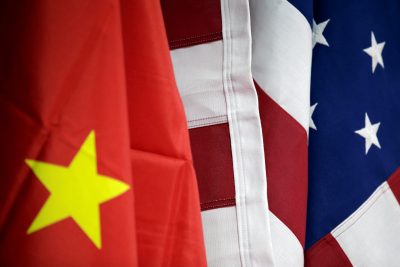Trade
Moving beyond the US–China Cold War cliche

Author: Suisheng Zhao, University of Denver
A bipolar world is emerging as the US–China rivalry dominates virtually every aspect of international politics. Bipolarity tends to exaggerate ideological hostility and encourages attempts to build exclusive alliances. Casting the rivalry as a battle between democracy and autocracy, the Biden administration has increased public criticism of China’s human rights violations and countered Chinese manoeuvring in the Pacific.
Portraying China as an existential threat, the United States has attempted to forge an alliance of democracies. Beijing has taken tit-for-tat actions to confront the United States and highlighted the superiority of the China model of authoritarianism in coping with the COVID-19 crisis. Enhancing strategic partnerships with Russia, Pakistan, Iran and other countries, Beijing has attempted to build a global ‘antihegemonic’ coalition.
But China’s ideological hostility is exaggerated. Beijing has not defined itself as the vanguard to transplant its systems throughout the world like the Soviet Union promoted communism and the United States promoted democracy. China’s version of authoritarianism — advanced through high-tech surveillance — does not offer a morally compelling alternative to liberal democracy for most countries.
Beijing is more afraid of Washington’s advocacy of expanding democracy into China than the United States is afraid of China’s authoritarianism. Instead of engaging in a determined effort to spread autocracy, Beijing has constructed an information firewall and tightened domestic ideological control. Rejecting liberal values as universal, China has sought primarily to make the world more accommodating to the Chinese Communist Party’s rule.
The ideological threat posed by the United States is also exaggerated. No longer the beacon of democracy, once almost-universal admiration has given way to disappointment over the displays of racial tensions, political polarisation, socioeconomic inequality and xenophobia. The devastating results of the United States using force to spread democracy, illustrated by the wars in Iraq and Afghanistan, have undermined support for democracy and generated anti-Americanism. US power has been in relative decline and its resilience has been seriously tested. The United States must put its own house in order before it can successfully wage a principled campaign against China.
Attempts to build exclusive alliances are also misperceived. US–China bipolarity does not match the classic vision of a colliding set of equivalent great powers. The United States and China are superpowers and are competing for dominance, but the European Union, Russia, Japan and India remain independent and may upset the power balance.
Many US allies and partners don’t want to be squeezed in between. They have different economic and strategic priorities, and varying threat perceptions. US President Joe Biden has faced up-hill battles to enlist like-minded nations against China. With no illusion about US strength, these countries have weighed the costs and benefits and made their decisions accordingly. Navigating the ever-changing rivalry, many US allies have stood up to China because of its threats to their economic and strategic interests but have also not decisively taken the US side and even confronted the US to safeguard their own interests. The announcement of AUKUS saw Australia cut its $66 billion diesel-electric submarine deal with France. Calling it a ‘stab in the back’, Paris reacted furiously and recalled its ambassadors to both the US and Australia. AUKUS has strained relations with America’s oldest European ally.
Similarly, Beijing has not built an anti-American alliance based on an ideological litmus test, but on complementary grievances against the threats posed by the United States. China’s strategic partnerships are more transactional than sentimental.
The world is not split into two rigid ideological and geopolitical blocs yet.
The delicate balance of power between the United States and China has further complicated the emerging bipolarity. Chinese President Xi Jinping has approached Washington from a perceived position of strength, no longer bending to pressure and accommodating its demands without conditions. But China’s projected confidence tends to paper over its domestic challenges and insecurity. It is unclear if China can become the first authoritarian regime to avoid the middle-income trap that has kept many emerging economies from becoming high-income countries.
China has…
Trade
Self-Reliance and Openness: Core Principles of China’s Third Plenary Session

The Third Plenum communique from the CCP indicates a prioritization of stability and compromise in response to China’s economic challenges. It highlights the concept of Chinese-style modernization and establishes political guidelines for balancing regulation and market forces.
The CCP’s Third Plenum communique signals a focus on stability and compromise in the face of China’s economic challenges. It emphasises Chinese-style modernisation and sets political directions for balancing regulation and market forces. While not as groundbreaking as previous plenums, it acknowledges the importance of market mechanisms and technological self-reliance, aiming to address issues like high youth unemployment and private sector uncertainty. The communique seeks to navigate the complexities of global competition and domestic innovation, potentially reshaping global supply chains and trade dynamics. Overall, it presents a pragmatic blueprint for China’s economic future.
Source : Self-reliance and openness central pillars of China’s Third Plenum | East Asia Forum
Trade
Trade Prevails Over Political Persuasions in China-Germany Relations

China and Germany maintain a strong bilateral relationship, rooted in economic cooperation despite ideological differences. Recent visits and agreements focus on expanding trade and addressing mutual concerns, navigating challenges while nurturing ties.
Evolving Bilateral Ties
China and Germany share a strong bilateral relationship, rooted in history since 1972. This connection has seen moments of cooperation intertwined with periods of tension. German Chancellor Olaf Scholz’s April 2024 visit underscores Germany’s commitment to fostering this partnership, reflecting a mutual interest in maintaining economic ties despite ideological differences.
Economic Pragmatism
As the second and third largest global economies, China and Germany’s economic interdependence is crucial. Germany emerged as China’s primary trading partner in 2023, with trade values reaching €254.4 billion (US$280 billion). In response to global scrutiny, Germany has taken a balanced approach, emphasizing economic stability over political discord. This was evident during Scholz’s prior visit in November 2022, where his diplomatic tone contrasted with broader EU sentiments.
Facing Challenges Together
Despite increasing public skepticism in Germany regarding China’s global influence and human rights issues, both nations continue to seek common ground. Their October 2023 Joint Statement highlights intentions to pursue cooperation in areas like carbon neutrality and open markets. To navigate these complex terrains, Germany can utilize its institutional frameworks to enhance dialogue, while also considering supply chain diversification to reduce dependency on China. The intertwining nature of their economies suggests that, despite challenges, both countries will continue to prioritize their substantial trade relations.
Source : Trade trumps political persuasions in China–Germany relations
Trade
Fixing fragmentation in the settlement of international trade disputes

Fragmentation in global trade due to the lack of development in multilateral trade rules at the WTO has led to an increase in FTAs. The Appellate Body impasse has further exacerbated fragmentation, requiring a multilateral approach for reform.
Fragmentation in Global Trade
Fragmentation in global trade is not new. With the slow development of multilateral trade rules at the World Trade Organization (WTO), governments have turned to free trade agreements (FTAs). As of 2023, almost 600 bilateral and regional trade agreements have been notified to the WTO, leading to growing fragmentation in trade rules, business activities, and international relations. But until recently, trade dispute settlements have predominantly remained within the WTO.
Challenges with WTO Dispute Settlement
The demise of the Appellate Body increased fragmentation in both the interpretation and enforcement of trade law. A small number of WTO Members created the Multi-Party Interim Appeal Arbitration Arrangement (MPIA) as a temporary solution, but in its current form, it cannot properly address fragmentation. Since its creation in 2020, the MPIA has only attracted 26 parties, and its rulings have not been consistent with previous decisions made by the Appellate Body, rendering WTO case law increasingly fragmented.
The Path Forward for Global Trade
Maintaining the integrity and predictability of the global trading system while reducing fragmentation requires restoring the WTO’s authority. At the 12th WTO Ministerial Conference in 2022, governments agreed to re-establish a functional dispute settlement system by 2024. Reaching a consensus will be difficult, and negotiations will take time. A critical mass-based, open plurilateral approach provides a viable alternative way to reform the appellate mechanism, as WTO Members are committed to reforming the dispute settlement system.
Source : Fixing fragmentation in the settlement of international trade disputes






